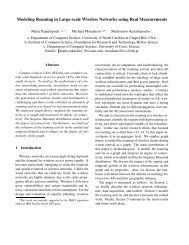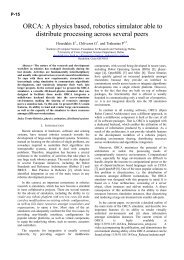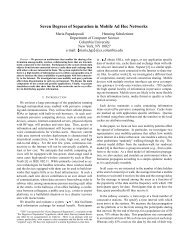Master Thesis - ICS
Master Thesis - ICS
Master Thesis - ICS
Create successful ePaper yourself
Turn your PDF publications into a flip-book with our unique Google optimized e-Paper software.
Computer Science Department<br />
Antonis Misargopoulos<br />
• Software discovery services discover and select the best software implementation and<br />
execution platform based on the parameters of the problem being solved [32]. Examples<br />
include NetSolve [33] and Ninf [34].<br />
• Community authorization servers enforce community policies governing resource<br />
access, generating capabilities that community members can use to access community<br />
resources. These servers provide a global policy enforcement service by building on<br />
resource information, and resource management protocols (in the Resource layer) and<br />
security protocols in the Connectivity layer. Akenti [35] addresses some of these issues.<br />
• Community accounting and payment services gather resource usage information for the<br />
purpose of accounting, payment, and/or limiting of resource usage by community<br />
members.<br />
• Collaboratory services support the coordinated exchange of information within<br />
potentially large user communities, whether synchronously or asynchronously. Examples<br />
are CAVERNsoft [36], Access Grid [37], and commodity groupware systems.<br />
These examples illustrate the wide variety of Collective layer protocols and<br />
services that are encountered in practice. While Resource layer protocols must be general<br />
in nature and are widely deployed, Collective layer protocols span the spectrum from<br />
general purpose to highly application or domain specific, with the latter existing perhaps<br />
only within specific VOs.<br />
Collective functions can be implemented as persistent services, with associated<br />
protocols, or as SDKs (with associated APIs) designed to be linked with applications. In<br />
both cases, their implementation can build on Resource layer (or other Collective layer)<br />
protocols and APIs. For example, figure 2.2 shows a Collective co-allocation API and<br />
SDK (the middle tier) that uses a Resource layer management protocol to manipulate<br />
underlying resources. Above this, there is a co-reservation service protocol and<br />
implement a co-reservation service that speaks this protocol, calling the co-allocation API<br />
to implement co-allocation operations and perhaps providing additional functionality,<br />
such as authorization, fault tolerance, and logging. An application might then use the coreservation<br />
service protocol to request end-to-end network reservations.<br />
18

















